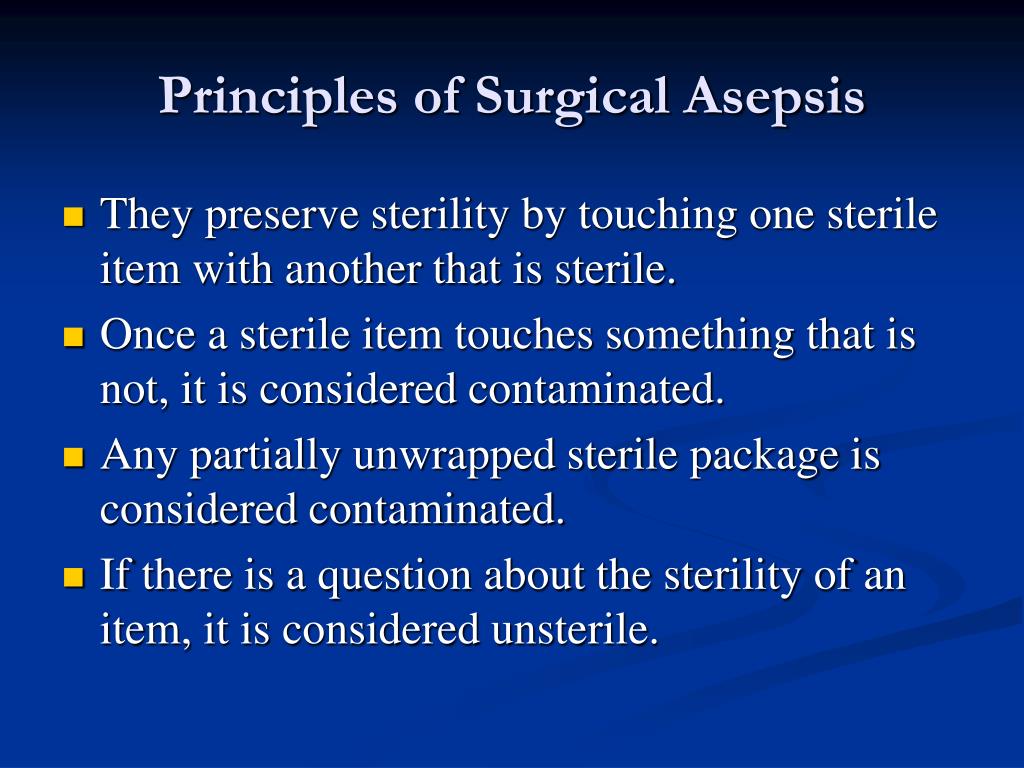

Rationale: This helps prevent spreading infection to yourself or others. Wear a gown or apron when your clothing could become soiled.Proper handwashing helps stop the spread of infection. Rationale: This helps prevent transfer of microorganisms between clients or between clients and the environment.
#Basic medical asepsis skin

Double gloves may be worn in certain circumstances.

IN PRACTICE: NURSING CARE GUIDELINES 41-1 The goal is to prevent reinfection of the client and prevent or reduce transmission of microorganisms from one person (or Medical asepsis (clean technique) is discussed in this topic surgical asepsis.Medical asepsis refers to the practice of reducing the number of microorganisms. There are two kinds of asepsis: medical and surgical. MEDICAL ASEPSISĪsepsis refers to practices that minimize or eliminate pathogenic organisms. These topics are introduced in this and the next topic and will be referred to throughout this topic. Maintenance of sterility of needles, catheters, and so forth.Proper disposal/cleanup of all linens, used equipment, medication packages, and biohazardous materials.Handling all sharps safely (never recap or break off a needle dispose of all sharps in the designated container).All personnel are expected to follow these guidelines when giving any client care. Signs reminding all healthcare personnel to use Standard Precautions are posted in prominent places throughout any healthcare facility.Wearing gloves and other protective equipment as needed.Thorough handwashing (with soap and water or antibacterial solution).Maintenance of the nurse’s personal immunizations.It is every nurse’s responsibility to be thoroughly familiar with these guidelines (In Practice: Nursing Care Guidelines 41-1). If you have any questions, consult the procedures in your facility. It is vital to protect the nurse and other clients. All exposures to blood or other body fluids have the potential to cause infection. Clients may not know they have an infection or they may not divulge the fact. Because we can never be sure of a client’s infectious status, all clients are treated as though they are infectious. This includes healthcare workers outside the hospital, such as dentists, acupuncturists, home care nurses, and clinic nurses. Standard Precautions are to be followed at all times by nurses and all other healthcare personnel when delivering any care or performing any procedures. These guidelines are called Standard Precautions (Fig. STANDARD PRECAUTIONSīecause it is impossible to know which clients may be carrying communicable diseases, the Centers for Disease Control and Prevention (CDC) established a set of guidelines to be used in the delivery of all healthcare. Practicing techniques of medical asepsis will help protect you, your clients, and your coworkers from infection. Preventing infections is vital to any healthcare facility’s operation and to the provision of healthcare in the community and in the home. Describe the nurse’s role in disposal of biohazardous waste and in cleaning up biohazardous materials.

In the skills laboratory, demonstrate teaching of infection control to a client or family member.ġ0. In the skills laboratory, demonstrate the use of barrier techniques.ĩ. List the most commonly used personal protective equipment.Ĩ. State when hand sanitizers may safely be used.ħ. In the laboratory, demonstrate proper handwashing technique after routine client care, before contact with a severely immunocompromised client, and after performing an invasive procedure. State the single most effective nursing measure in preventing spread of disease.Ħ. Explain how antimicrobial agents and environmental controls contribute to medical asepsis.ĥ. Describe the elements of medical asepsis. Identify the factors that predispose clients to nosocomial infections.Ĥ. Differentiate between endogenous and exogenous organisms.ģ. Describe basic procedures of Standard Precautions state why they are used.Ģ.


 0 kommentar(er)
0 kommentar(er)
